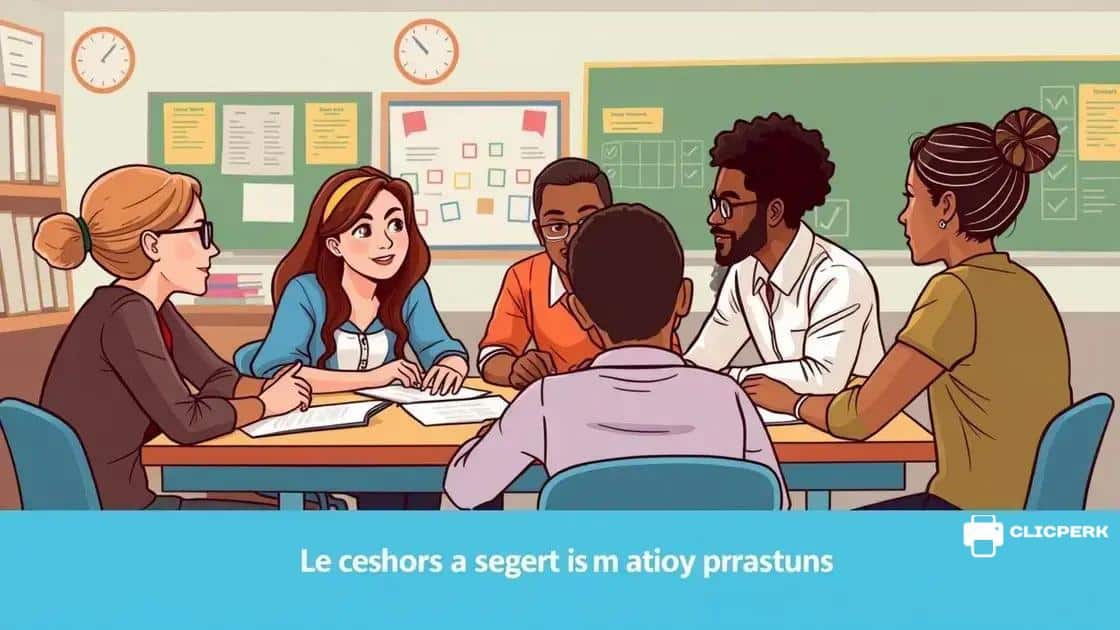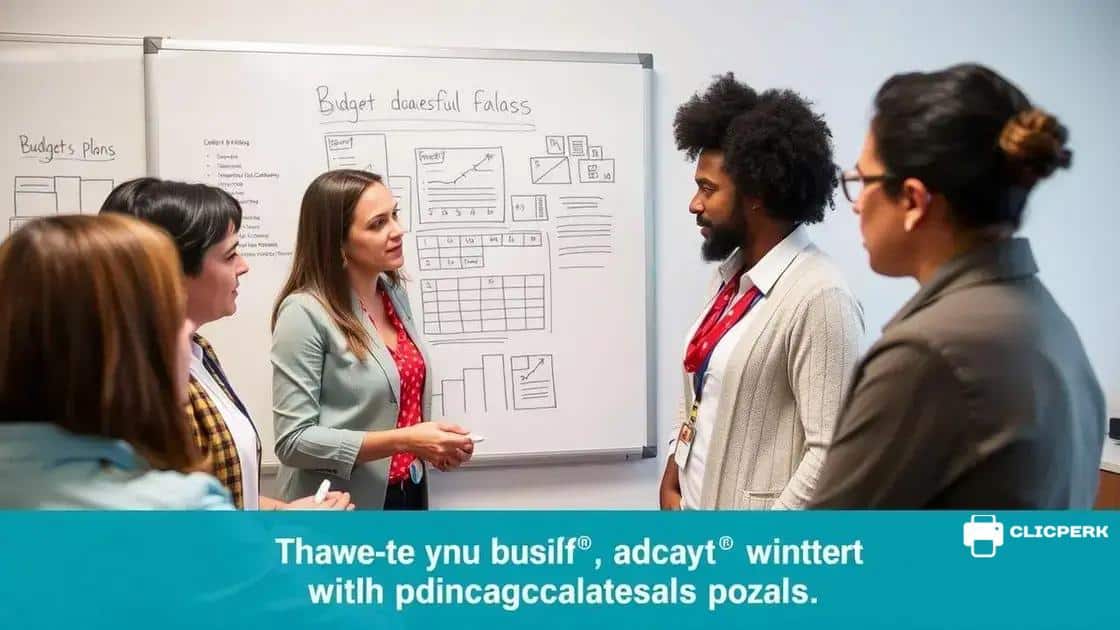Education program budget proposals that work for everyone

Education program budget proposals must be clear, accurately estimated, and include stakeholder engagement to ensure funding success and meet community needs effectively.
Education program budget proposals play a crucial role in shaping the future of learning. They can determine how resources are allocated and what programs thrive, influencing the educational landscape significantly. What if you could craft a proposal that not only secures funding but also meets the diverse needs of your community?
Understanding the basics of budget proposals
Understanding the fundamentals of budget proposals is essential for effectively securing funding for educational programs. A solid budget proposal can greatly influence the success of your initiatives by demonstrating transparency and feasibility.
Key Elements of Budget Proposals
Every budget proposal should include several critical components. By clearly outlining these aspects, you can build a compelling case for funding.
- Goals and Objectives: Clearly define the objectives of your program and what you aim to achieve.
- Itemized Budget: Provide a detailed list of expenses, including personnel, materials, and operational costs.
- Justification: Explain why each expense is necessary for achieving program goals.
- Timeline: Outline a schedule that shows when funds will be needed and how they will be used over time.
It’s equally essential to convey the significance of the proposed program. Highlight how it will benefit the community or targeted group. This not only strengthens your case but also engages potential stakeholders.
Common Mistakes to Avoid
When drafting your budget proposal, be aware of several common pitfalls. These mistakes can hinder your chances of receiving funding. Avoid vague language that lacks clarity, as well as incomplete financial information that leaves evaluators uncertain about the viability of your program.
Budget proposals should also focus on realistic projections. Overestimating expenses or projecting overly ambitious outcomes can lead to skepticism. Instead, aim for accuracy to build trust with funders.
Throughout your proposal, use clear and professional language to make your case for funding. A well-crafted budget proposal not only details costs but also tells a story about the impact of your program.
Key components of an effective education budget
When creating an effective education budget, several key components must be addressed to ensure that the proposal is comprehensive and convincing. These elements help provide clarity and showcase the efficiency of allocated resources.
Essential Components of an Education Budget
The foundation of a strong budget proposal lies in its detailed structure. By focusing on specific areas, you can present a budget that resonates with stakeholders and funding bodies.
- Personnel Costs: Clearly outline salaries, benefits, and any other compensation for staff involved in the program.
- Materials and Supplies: Include necessary educational materials, technology, and supplies needed for effective program implementation.
- Facilities and Maintenance: Detail any costs related to the facilities where the program will be conducted, along with maintenance if required.
- Professional Development: Allocate funds for training and development activities that enhance staff skills and improve educational outcomes.
In addition to outlining these costs, it is vital to emphasize how each component aligns with the overall goals of the educational program. This alignment helps justify expenditures and provides a roadmap to achieving desired outcomes.
Budget Justification
Every line item in the budget should come with a clear rationale. Justification not only supports the request for funds but also demonstrates accountability to stakeholders. Funders want to know that their investment will yield positive results.
To achieve this, articulate how each component contributes to the success of the educational program. Share data or examples that illustrate potential impacts. Use evidence-based arguments to reinforce the importance of different budget elements.
Lastly, a well-organized budget communicates professionalism and preparedness. Consider employing visual aids like charts or graphs to represent your budget visually. This can make it easier for reviewers to digest complex information and see the overall picture at a glance.
How to align budgets with educational goals

Aligning budgets with educational goals is crucial for ensuring that funds are used effectively. A thoughtful alignment helps in maximizing resources while achieving desired outcomes in education.
Identifying Educational Goals
First, it’s important to identify the primary goals of the educational program. Establish clear objectives that outline what you hope to achieve. These may include improving student performance, increasing student engagement, or expanding access to resources.
- Define Specific Objectives: Make sure the goals are specific and measurable to assess progress accurately.
- Involve Stakeholders: Gather input from teachers, parents, and students when setting these goals to ensure they reflect community needs.
- Prioritize Goals: Rank goals based on their importance and feasibility, helping guide budget allocation effectively.
With clearly defined goals, the next step is to ensure that every budget line aligns with these objectives. This will help create a cohesive strategy that directs resources toward the most impactful initiatives.
Mapping Budget Allocations
Once the educational goals are established, map budget allocations to these targets. Each expense should correlate to a specific objective, making it easier to justify spending.
For instance, if improving student engagement is a goal, allocate funds for activities, materials, and technologies that enhance interaction. This not only demonstrates purpose but also fosters accountability.
Continuously review and adjust your budget as necessary. By monitoring expenditures and outcomes, you can make informed decisions about where to redirect funds to better meet goals.
Collaborate with team members to ensure alignment throughout the budgeting process. Make regular check-ins to discuss progress and reassess priorities as needed. This collaborative method will boost transparency and ensure everyone is working toward the same end goals.
Strategies for proposing innovative education programs
Proposing innovative education programs requires careful planning and strategic thinking. To create a compelling proposal, consider using various approaches that showcase creativity and effectiveness.
Understanding the Needs
Start by identifying the specific needs of your target audience. Conduct surveys or focus groups to gather insights from students, teachers, and community members. Understanding these needs helps tailor your program to address real challenges.
- Gather Feedback: Use feedback to shape your program ideas, ensuring they resonate with stakeholders.
- Research Best Practices: Look into successful programs elsewhere for inspiration and insights that can be adapted to your context.
- Align with Goals: Make sure your proposal aligns with broader educational goals and policies.
Once you have a clear understanding of the needs, brainstorm innovative ideas that provide solutions. Consider involving a diverse team in this process, as different perspectives can enhance creativity.
Creating a Clear Plan
A strong proposal outlines a clear plan for implementation. This includes defining objectives, timelines, and necessary resources. Highlighting how your innovative program will function in practice makes it more appealing.
Incorporate methods for tracking progress and success. Establish benchmarks to evaluate the effectiveness of the program over time. These elements show that you are committed to accountability and improvement.
Provide examples of how similar programs have succeeded in other contexts, showcasing their impact. Use data to support these claims, demonstrating potential outcomes based on evidence.
Engaging Stakeholders
Involve key stakeholders throughout the proposal process. Present your ideas to educators, parents, and community leaders to gain their support and insights. This collaboration can also lead to additional resources or partnerships.
Consider hosting workshops or presentations where you can discuss your ideas and gather input. Engaging others not only boosts interest but also fosters a sense of ownership over the program.
Finally, don’t forget to emphasize the long-term benefits of your innovative education program. Show how it will transform learning experiences, improve student outcomes, and positively impact the community as a whole.
Common pitfalls in education budget proposals
Creating an education budget proposal can be complex, and there are many common pitfalls to avoid. Recognizing these challenges can help you improve your chances of success.
Lack of Clarity
One of the primary issues in budget proposals is a lack of clarity. When financial details are vague, it can confuse stakeholders and lead to misunderstandings. Clearly define your budget categories and provide detailed descriptions for each line item.
- Be Specific: Avoid general terms. Instead, detail every cost related to personnel, materials, and other necessary expenses.
- Organize the Information: Use charts or tables to present your budget in an easy-to-read format.
- Use Clear Language: Ensure that non-experts can understand your proposal without technical jargon.
Another common mistake is failing to justify expenditures. Every budget item should explain why the funds are necessary. This helps stakeholders see the value in your proposal and understand its alignment with educational goals.
Overestimating or Underestimating Costs
Budgeting accurately is crucial, and many proposals suffer from miscalculating expenses. Overestimating costs can make your proposal less convincing, while underestimating can lead to funding shortfalls later on. It’s essential to base your estimates on reliable data.
- Research Market Rates: Look at similar programs to gauge accurate cost expectations.
- Factor in Contingencies: Include a buffer for unexpected expenses to avoid budget overruns.
- Consult Experts: Seek input from financial advisors or colleagues who have experience in educational budgeting.
Maintaining flexibility is also important. Not all funding will come through as expected, and having a plan for reallocating resources can help keep your project on track. Regularly review your budget to ensure it stays aligned with your goals and funding realities.
Ignoring Stakeholder Input
Lastly, failing to include input from key stakeholders can lead to proposals that do not meet community needs. Engaging with teachers, parents, and community members can provide valuable perspectives and support for your proposal.
Hold meeting sessions to discuss your proposal and encourage feedback. This collaboration can enhance your proposal and may unveil needs or expenses you initially overlooked. Building a strong network of advocates also strengthens your proposal’s chances for approval.
In conclusion, developing a strong education budget proposal requires careful attention to detail and awareness of common pitfalls. By ensuring clarity, accurately estimating costs, and engaging stakeholders, you can create a compelling budget that meets the needs of your program. Remember to regularly review and adjust your proposal, allowing for flexibility in funding and execution. With these strategies, you can enhance your chances of successful funding and support for your educational initiatives.
FAQ – Common Pitfalls in Education Budget Proposals
What is the biggest mistake to avoid in budget proposals?
The biggest mistake is lack of clarity. Ensure all budget items are detailed and explained clearly to avoid confusion.
How can I estimate costs accurately?
Accurate cost estimation can be achieved by researching similar programs and accounting for all potential expenses.
Why is stakeholder engagement important?
Engaging stakeholders helps to gather valuable feedback and ensures that the proposal meets the needs of the community.
How often should I review my budget proposal?
You should review your budget proposal regularly to adjust for changes in circumstances and to ensure alignment with educational goals.





